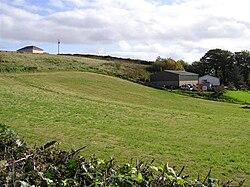Drumardagh
Drumardagh
Droim Ardagh | |
|---|---|
Townland | |
 Part of Drumardagh Middle | |
| Motto: Altus Nemus Exsequor Per Panoramic Visum | |
| Coordinates: 54°57′18″N 7°39′00″W / 54.955°N 7.650°W | |
| Country | Ireland |
| Province | Ulster |
| County | County Donegal |
| Government | |
| • Dáil Éireann | Donegal |
| Time zone | UTC+0 (WET) |
| • Summer (DST) | UTC-1 (IST (WEST)) |
| Website | www |
Drumardagh (Irish: Droim Ardagh) is a townland in the east of County Donegal in Ulster, Ireland. The townland is about 5 kilometres (around 3 miles) east of Letterkenny in the Laggan district of East Donegal.[1] The townland is just outside the village of Manorcunningham. The Isle Burn flows along the eastern boundary of the townland. The Irish name means 'the Ridge (drum) on the High Place (ardagh)', and it is this elevation that gives Drumardagh its commanding views over Lough Swilly, from Glenswilly to Inch Island, and beyond to the peaks of the Fanad and Inishowen peninsulae.
History
[edit]Due to its elevated location, and the surrounding lowland isles on the banks of Lough Swilly, Drumardagh has a history of military significance. The first notable use of the hill in Drumardagh was as a strategic viewing point for the nearby Battle of Farsetmore on 8 May 1567.[2] Drumardagh and surrounding areas of the Laggan district were heavily 'planted' with Lowland Scots settlers during the Plantation of Ulster in the seventeenth century.[3] Hence, a version of Ulster-Scots was spoken in the area, in common with the rest of the Laggan.
In 1790, the British Army erected a stone building in the farmyard at Drumardagh, which they used as a cavalry and munitions store. On the north-westernmost tip of Drumardagh, directly overlooking Lough Swilly, trenches were dug into the hillside, at a place which is known locally as the Cannon Knowe or the Cannon Hill. These trenches were used by the British as a means of maintaining watch over the nearby shipping channel, which at that time was a busy communications link into and out of central County Donegal. Several cannons have been recovered from this site, and an example is now under the care of the nearby Letterkenny Museum.
References
[edit]- ^ Minutes of Meeting of Letterkenny Electoral Area Committee, 24 January 2005.
- ^ G.A. Hayes McCoy, Irish Battles, Belfast, 1989.
- ^ Thomas McErlean, 'Chapter 4: The Archaeology and History of Lough Swilly' in Andrew Cooper (Editor), Lough Swilly: A Living Landscape, p. 89. Four Courts Press, Dublin, 2011.


